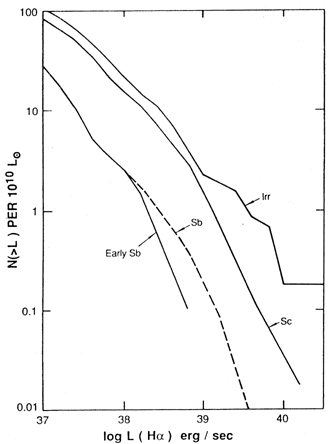Copyright © 1994 by Annual Reviews. All rights reserved
| Annu. Rev. Astron. Astrophys. 1994. 32:
115-52 Copyright © 1994 by Annual Reviews. All rights reserved |
H II Regions

Figure 6. The cumulative HII region luminosity function for different galaxy types from Kennicutt et al. (1989b). |
Regions of ionized hydrogen are one of the distinguishing features of
galactic morphology. The first quantitative description relating galaxy
type and H II regions is given by
Sersic (1960)
who studied their sizes as
measured on broad-band photographic plates. More recently, major progress
has been made by Kennicutt and his colleagues using H imaging in their
study of nearly 100 galaxies. In a series of seminal papers
(Kennicutt 1988;
Kennicutt et al. 1989;
Kennicutt 1989)
a census of H II
region properties is given for a galaxy type range of Sa-Im. Summarized
here are those that are related to morphological type.
Figure 6 (taken
from
Kennicutt et al. 1989)
which shows the cumulative H II region luminosity function for galaxies
of different type illustrates some of these points:
imaging in their
study of nearly 100 galaxies. In a series of seminal papers
(Kennicutt 1988;
Kennicutt et al. 1989;
Kennicutt 1989)
a census of H II
region properties is given for a galaxy type range of Sa-Im. Summarized
here are those that are related to morphological type.
Figure 6 (taken
from
Kennicutt et al. 1989)
which shows the cumulative H II region luminosity function for galaxies
of different type illustrates some of these points:
| 1. | The brightest H II regions in late-type systems are on
average ~ 50 times more luminous than the brightest in
early-type spirals. Galaxies intermediate in type have their
brightest H II regions intermediate in value, again, on average; the
dispersion is large. The number of bright H II regions per unit galaxy
luminosity or
the number expressed as a surface density varies systematically with
type. Both measures are smallest for early-type spirals (Sab-Sb)
and largest for Sm-Im. The difference in the mean is close to an
order of magnitude. These results are for H II regions of H luminosity > 1 x 1038 erg s-1 (and can extend to
1040.8
ergs s-1). For comparison Orion has L(H
luminosity > 1 x 1038 erg s-1 (and can extend to
1040.8
ergs s-1). For comparison Orion has L(H ) ~ 1037 ergs s-1. ) ~ 1037 ergs s-1.
|
| 2. | The diameters of the first-rank H II regions vary in a similar sense: The larger ones are found in the later-type systems for galaxies of similar absolute magnitude. This luminosity normalization allows for any possible size-number effect. |
| 3. | The slope of the luminosity functions for H II regions in different galaxies shows a weak but systematic trend with type, with later-type system having a shallower slope. The bright end of the luminosity function shows a systematic truncation in the sense that earlier type galaxies are lacking in bright H II regions. Kennicutt et al. (1989) illustrate this point by noting that 30 Dor in the LMC is ~ 20 times brighter than any H II region in M31, a much larger galaxy of type Sb. Furthermore the ten brightest H II regions in the LMC are all brighter than M31's brightest. |
All of these trends indicate a massive star formation rate that is determined by the galaxy type in which it occurs. Related is the systematic occurrence of the brightest stellar associations in the later-type galaxies (Wray & de Vaucouleurs 1980).
Kennicutt (1989)
examined the relationship between the (disk-averaged)
H surface brightness and the HI
and CO surface density
and found a threshold value for the latter, ~ 3 M
surface brightness and the HI
and CO surface density
and found a threshold value for the latter, ~ 3 M pc-2, below
which star formation is rare. He notes that
Toomre's (1964)
model for the stability of a simple single-fluid disk is consistent with
these results.
Hogg et al. (1993)
find a similar threshold value
for the onset of star formation within a sample of S0's and Sa's.
pc-2, below
which star formation is rare. He notes that
Toomre's (1964)
model for the stability of a simple single-fluid disk is consistent with
these results.
Hogg et al. (1993)
find a similar threshold value
for the onset of star formation within a sample of S0's and Sa's.
These results are encouraging in supporting an intuitive expectation that star formation proceeds where there is ``enough'' material to do so. An understanding of the next link as to why the bright end of the initial mass function varies with galaxy type will offer an important insight into massive star formation.